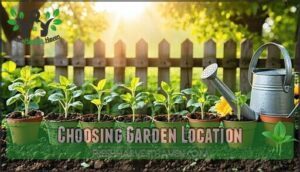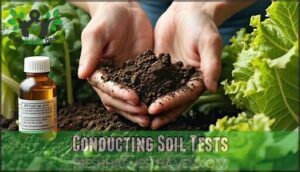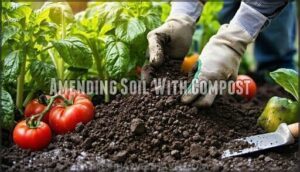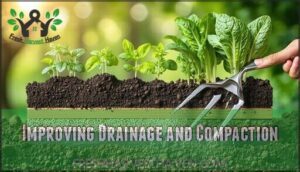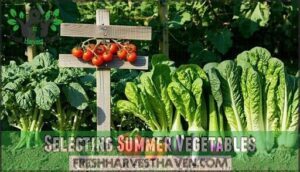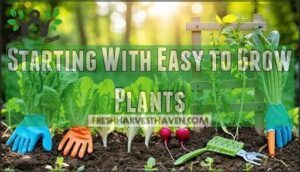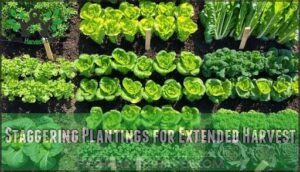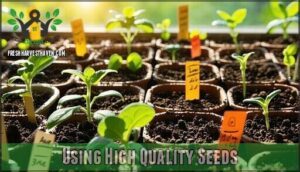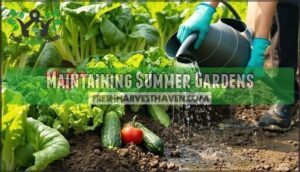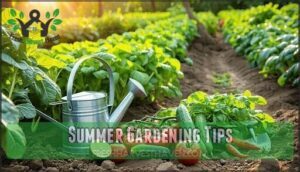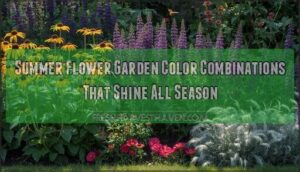This site is supported by our readers. We may earn a commission, at no cost to you, if you purchase through links.
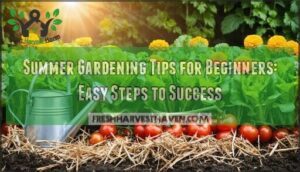
Water deeply but less frequently—your plants’ roots will thank you. Mulch around plants to retain moisture and suppress weeds.
Don’t forget to deadhead flowers and keep an eye out for pests. The secret isn’t having a green thumb; it’s staying consistent with these summer gardening tips for beginners.
Once you nail these fundamentals, there are clever tricks that’ll turn your modest plot into a thriving paradise.
Table Of Contents
- Key Takeaways
- Choosing Garden Location
- Preparing Garden Soil
- Selecting Summer Vegetables
- Planting Summer Gardens
- Maintaining Summer Gardens
- Summer Gardening Tips
- Frequently Asked Questions (FAQs)
- What are some tips for summer plant care?
- How do I start a garden for a beginner?
- Are there any gardening tips for beginners?
- How do I Make my Garden look better all year round?
- What makes a good gardener?
- How do you make a good garden?
- What is the rule of 3 in gardening?
- What is the most common mistake of first time gardeners?
- What is the gardening 3 year rule?
- When should I start my summer garden?
- Conclusion
Key Takeaways
- Choose a sunny spot and prep your soil with compost before planting.
- Start with easy, beginner-friendly crops like tomatoes, lettuce, and marigolds to build confidence.
- Water deeply but less often, mulch to retain moisture, and keep weeds and pests in check.
- Stay consistent with maintenance—deadhead flowers, support plants, and watch for signs of trouble.
Choosing Garden Location
Your garden’s location sets the stage for summer success, so you’ll want to scout out a spot that gets plenty of morning sun and has good drainage.
Think of it as real estate for plants – location matters more than you might expect, and getting it right from the start saves you headaches later.
Assessing Sunlight Needs
Sunlight in summer gardening acts like a plant’s daily breakfast—it’s absolutely essential for healthy growth.
Your garden’s daily dose of sunshine is like morning coffee for plants—they absolutely need it to wake up and grow strong.
Your vegetables need 6-8 hours of direct sunlight daily to thrive and produce abundant harvests.
Here’s how to assess your garden’s sunlight requirements:
- Track sunlight duration throughout different yard areas using a simple notebook or phone app
- Map shade patterns by observing how shadows move across potential planting spots hourly
- Consider seasonal changes since summer sun angles shift and affect light intensity differently
- Test reflected light from nearby walls, fences, or surfaces that might boost plant placement options
Understanding shade tolerance helps you match summer plants to their ideal spots.
Some crops handle partial shade while others demand full sun exposure.
This beginner gardening guide principle guarantees your summer gardening tips actually work in practice.
Evaluating Soil Quality
Once you’ve picked your sunny spot, soil quality becomes your foundation for gardening success.
Test your soil pH, nutrient levels, and soil texture using an inexpensive soil test kit from any garden center.
Healthy soil health means dirt that crumbles in your hands and contains plenty of organic matter—think dark, rich earth that smells earthy, not sour.
Poor drainage capacity creates soggy conditions that kill roots faster than you can say "oops."
This beginner gardening guide step saves you from plant disappointments later.
Quality soil sets up your summer gardening tips for real success in your beginner gardening journey.
Ensuring Proper Drainage
Don’t let poor drainage turn your summer gardening into a muddy mess.
Good drainage keeps roots breathing and prevents waterlogging effects.
Here’s a quick test:
- Dig a 12-inch hole.
- Fill it with water.
- Watch how fast it drains.
- If it’s slow, improve soil composition with compost, raised beds, or French drains.
Solid drainage solutions boost soil health, prevent erosion, and help container drainage.
Consider using mulch to help with soil moisture retention.
Smart garden tips like these keep your plants thriving all summer with good soil health!
Selecting Ideal Plot Size
After ensuring good drainage, you’ll need to reflect on your garden space needs. Starting with the right plot size prevents overwhelm and sets you up for success.
A 4×8-foot vegetable garden works perfectly for beginners. It’s manageable yet provides enough room for diverse plantings. This size allows easy access from all sides without stepping on soil.
Reflect on your plant yield goals and available space limitations. A small plot teaches fundamentals without demanding too much time. You can always expand next season as your confidence grows.
| Plot Size | Best For |
|---|---|
| 4×4 feet | First-time gardeners |
| 4×8 feet | Beginner variety planting |
| 8×8 feet | Experienced beginners |
Think of your first garden as practice, not perfection. Future garden expansion becomes easier once you’ve mastered the basics in a smaller space.
Preparing Garden Soil
Your garden’s soil quality determines whether your plants thrive or struggle through the hot summer months ahead.
Proper soil preparation now sets the foundation for a bountiful harvest that’ll make your neighbors peek over the fence with envy.
Conducting Soil Tests
Testing soil gives you the roadmap for garden success. Think of it as getting a health checkup for your dirt before planting anything important.
Why soil testing matters:
- Testing frequency should happen every 2-3 years to track changes and maintain ideal growing conditions
- DIY kits offer quick results at home, while professional labs provide detailed nutrient breakdowns and specific recommendations
- Interpreting results helps identify pH problems, nutrient gaps, and organic matter levels that affect plant health
- Soil amendments become targeted solutions rather than guesswork, saving money and improving summer soil care
Professional labs beat home kits for accuracy, but both work for basic soil preparation needs. Most vegetables thrive in slightly acidic soil between 6.0-7.0 pH. Testing prevents common problems like yellow leaves and poor harvests.
Amending Soil With Compost
Your soil’s foundation needs the right organic matter to thrive, and compost delivers unmatched compost benefits for summer soil care. Think of compost as your garden’s multivitamin—it transforms ordinary dirt into nutrient-rich paradise.
Different compost types serve specific purposes in soil preparation:
| Compost Type | Best Application |
|---|---|
| Homemade kitchen scraps | General vegetable gardens |
| Aged manure | Heavy-feeding crops like tomatoes |
| Leaf mold | Acid-loving plants and flowers |
Application methods matter for maximum nutrient density. Spread 2-3 inches across your garden bed, then work it into the top 6 inches of existing soil. This creates better soil structure while boosting water retention.
To guarantee the best growth, remember to assess your soil’s pH before amending it. Fresh compost can burn tender roots, so let it age at least six months. Your plants will reward you with vigorous growth when you feed the soil first. Quality organic matter turns struggling gardens into productive powerhouses, making these beginner tips essential for success.
Improving Drainage and Compaction
Good compost won’t fix everything if your soil feels like concrete underfoot. Compacted ground blocks water and air from reaching roots, leaving plants struggling to grow.
You can purchase suitable soil products to improve your garden.
- Amending Heavy Soil: Mix coarse sand or perlite into clay soil for better drainage and root penetration
- Raised Beds: Build 8-12 inch beds to control moisture and prevent waterlogging issues
- French Drains: Install gravel-filled trenches in persistently wet areas for proper water flow
- Soil Aeration: Use a garden fork to break up compacted layers and increase oxygen circulation
Adding Organic Matter
Once you’ve tackled drainage, it’s time to feed your soil with organic matter—the foundation of any successful beginner vegetable garden or beginner flower garden.
Organic matter transforms poor soil into a thriving ecosystem. Compost benefits include improved soil structure and enhanced nutrient cycling. Apply 2-3 inches of compost or 1-2 inches of aged manure for steady nutrition. Worm castings work like gold dust for your plants.
You can find gardening compost products online for your convenience.
| Organic Amendment | Application Rate | Primary Benefit |
|---|---|---|
| Compost | 2-3 inches | Nutrient cycling |
| Aged Manure | 1-2 inches | Slow-release nutrients |
| Leaf Mold | 3-4 inches | Moisture retention |
| Worm Castings | 1/2 inch | Plant growth boost |
| Shredded Bark | 2-4 inches | Weed suppression |
This manure application strategy feeds beneficial microorganisms that make nutrients available to plants. Your organic gardening efforts pay off with healthier summer gardening results.
Selecting Summer Vegetables
Choosing the right vegetables for your summer garden sets the stage for a bountiful harvest that’ll keep your kitchen stocked with fresh produce.
You’ll want to focus on heat-tolerant varieties that can handle scorching temperatures while still producing crisp, flavorful crops your family will actually eat, which is crucial for a successful summer garden with a bountiful harvest.
Cool Season Vegetables
Cool season vegetables shine in your beginner vegetable garden during spring planting and fall harvest seasons.
These crops handle chilly weather like champions before summer heat arrives.
Lettuce starts strong but needs shade to prevent bolting when temperatures rise.
Radishes zip from seed to harvest in just three weeks.
Peas love temperatures below 70°F and reward you with sweet pods.
- Cold frames extend growing seasons by protecting plants from frost
- Crop rotation prevents soil depletion and reduces pest problems
- Bolting prevention requires consistent watering and proper timing
Smart gardeners use these vegetables as stepping stones into summer gardening success.
Warm Season Vegetables
Warm-season vegetable plants come alive when soil temperatures reach 60°F consistently. You’ll want to focus on tomatoes, peppers, cucumbers, and zucchini for reliable high yields. These heat tolerant champions need full sun and well-draining soil to flourish.
| Vegetable | Watering Needs | Pest Resistance |
|---|---|---|
| Tomatoes | Deep, weekly | Moderate |
| Peppers | Moderate, consistent | High |
| Cucumbers | Frequent, shallow | Low |
Companion planting works wonders—try basil with tomatoes for better flavor and natural pest control. Space plants properly for good airflow, which prevents disease. These summer gardening basics help beginners grow successfully. Your vegetable garden will reward consistent care with fresh produce all season long.
Choosing Heat Tolerant Plants
Heat-tolerant plants are your secret weapon when summer temperatures soar above 85°F.
These champions maintain productivity while others wilt under pressure.
Best Varieties for Hot Weather Gardening:
- Okra and eggplant – produce consistently in soil temperatures up to 95°F
- Sweet potatoes and melons – thrive with deep roots accessing soil moisture
- Basil and oregano – herbs that survive heat waves without losing productivity
- Malabar spinach and amaranth – leafy greens continuing growth past 90°F
Look for thick, waxy leaves and deep root systems when selecting heat-tolerant plants.
These traits help plants handle sun requirements and reduce watering needs.
Choose varieties labeled "heat tolerant" from local nurseries for your specific soil preferences and summer plant care success.
Considering Family Preferences
Planning your summer gardening around family preferences keeps everyone involved and happy.
Skip the “mystery greens” no one eats, and focus on kid-friendly veggies, fun taste testing, and easy wins.
Think about dietary needs, and let everyone pick a favorite. Don’t bite off more than you can chew—choose crops that match your available time and space.
Gardening tips for beginners always include listening to your crew!
- Cherry tomatoes for snacking
- Snap peas for lunchboxes
- Strawberries for dessert
- Basil for pizza nights
- Rainbow carrots for garden education
Planting Summer Gardens
Once you’ve selected your vegetables, it’s time to turn your garden dreams into reality.
You’ll want to start with foolproof plants and use smart planting techniques to keep your harvest coming all season long.
Starting With Easy to Grow Plants
Most beginner friendly vegetables grow themselves with minimal fuss.
Start with lettuce, radishes, and green beans—they’re kid friendly and deliver fast harvests in just weeks.
These low maintenance crops work perfectly for container gardening too.
| Vegetable | Days to Harvest | Difficulty Level |
|---|---|---|
| Lettuce | 30-45 days | Super Easy |
| Radishes | 25-30 days | Foolproof |
| Green Beans | 50-60 days | Beginner Friendly |
Choose five varieties max to keep things manageable while you’re learning the ropes.
Staggering Plantings for Extended Harvest
Once you’ve picked easy plants, keep your garden producing by staggering your plantings.
Succession Planting and smart Planting Intervals help you avoid a veggie overload or drought. Rotate crops into spots where spring veggies finished, and mix early, mid, and late varieties to Extend Season and enjoy a Continuous Harvest.
Try these tips:
- Sow quick crops every two weeks
- Rotate summer crops
- Mix seasonal planting dates to achieve smart Planting Intervals.
Planting Native Species
When you choose native species, you’re working with plants that have mastered your local ecosystems over centuries.
These botanical locals offer impressive native benefits—they’re drought champions once established, dramatically reducing your need for constant watering and supporting water conservation efforts.
Native plants thrive effortlessly, conserve water, and attract pollinators, making your garden a low-maintenance haven full of life.
Native species bring color, resilience, and wildlife to your garden, turning every summer day into a pollinator party.
Native species naturally resist local pests and diseases, giving you built-in pest resistance without chemical interventions.
They’re also powerhouses for biodiversity support, attracting native bees, butterflies, and birds that depend on these familiar food sources.
Start by researching species native to your region—think Wild Bergamot, Black-eyed Susan, or native grasses.
These gardening basics make plant selection simpler since they’re already adapted to your soil and climate conditions.
Your summer gardening tips arsenal gets stronger when you include natives that bloom throughout the season, creating a self-sustaining garden ecosystem that practically manages itself while supporting local wildlife.
For example, the Edwards Plateau Ecoregion is known for its prominent spring wildflowers.
Using High Quality Seeds
Your summer garden’s success starts with quality seeds that’ll actually sprout when you need them. Skip the bargain bin packets—invest in seeds with high germination rates from reputable companies. You’ll thank yourself when your tomatoes and peppers actually grow instead of disappointing you with empty soil patches.
Seed viability matters more than you think. Fresh seeds from trusted sources give you the best shot at a thriving garden. Store leftover seeds in cool, dry places like mason jars to maintain their power for next season’s garden planning summer adventures.
Here’s your seed starting game plan:
- Check germination rates on packet labels—aim for 85% or higher
- Choose disease resistance varieties to avoid common summer plant problems
- Compare hybrid vs. heirloom options based on your gardening for beginners goals
- Practice seed saving from your best performers for future seasons
Smart seed choices set your summer gardening schedule up for success from day one.
Maintaining Summer Gardens
Once your plants are established, consistent maintenance keeps your garden thriving through the heat.
You’ll need to stay on top of watering, weeding, and feeding to guarantee your vegetables produce abundant harvests all season long.
Watering and Mulching
Now that you’ve planted your summer garden, keeping it healthy means getting your watering frequency and mulching right.
Water deeply in early morning when temperatures are cool – this prevents evaporation and helps plants build strong root systems.
Check soil moisture by sticking your finger two inches down; if it’s dry, it’s time to water.
Mulch types like straw, shredded bark, or grass clippings work wonders for water conservation and summer garden maintenance.
Regular inspection helps with pest and disease management.
Here’s your watering and mulching game plan:
- Water at soil level using efficient irrigation methods like soaker hoses
- Apply 2-3 inches of organic mulch around plants
- Water deeply but less frequently to encourage deep roots
- Use the finger test to check soil moisture before watering
- Create shallow basins around plants to direct water to roots
This approach keeps your garden thriving while saving water.
Controlling Weeds and Pests
Keeping your watered garden healthy means staying ahead of garden pests and unwanted growth.
Weed prevention starts with thick mulch—it blocks sunlight and keeps troublemakers from sprouting.
Pull weeds when they’re young and soil’s moist; they come out easier then.
For pest control summer challenges, beneficial insects are your allies.
Ladybugs demolish aphids while ground beetles hunt caterpillars.
Trap cropping works too—plant nasturtiums to lure cucumber beetles away from your main crops.
Pest identification helps you choose the right fix.
Holes in leaves? Look for caterpillars.
Sticky honeydew? Check for aphids underneath.
Organic pesticides like neem oil handle most problems without harsh chemicals.
To avoid harming helpful creatures, consider pesticide impacts by using natural methods.
Weed control summer gets easier with consistent morning sessions—just fifteen minutes daily beats weekend marathons.
Remember, healthy soil grows strong plants that naturally resist both pest control issues and weed pressure.
Providing Support for Plants
Ever watched a tomato plant flop over like it’s given up? That’s your cue for Staking Tomatoes early—trust me, it saves headaches later.
For Trellising Cucumbers or Supporting Melons, sturdy vertical gardening frames keep fruit off the ground and looking sharp.
Caging Peppers or eggplants with soft ties or clips works wonders. Bamboo stakes add a rustic touch to your summer garden projects.
These gardening tips help beginners keep plants upright, making watering summer garden beds and harvesting much easier.
Fertilizing for Optimal Growth
After providing proper support structures, your summer gardens need regular nutrition to keep producing. Think of fertilizing like feeding a growing teenager—they need consistent, quality meals to thrive.
Start with compost tea or manure tea for gentle, organic feeding every 3-4 weeks. These liquid gold solutions won’t cause nutrient burn like harsh chemicals might. Slow-release granular fertilizers work great too, feeding plants gradually over months.
Watch for yellowing leaves—your vegetable garden’s way of saying "I’m hungry!" Apply fertilizers during cool morning or evening hours for better absorption.
Key gardening tips for successful garden fertilization:
- Test soil first to avoid over-feeding and soil depletion
- Mix liquid fertilizers at half-strength for container plants
- Stop fertilizing 6 weeks before first expected frost.
Remember, well-fed plants resist pests better and produce more abundant harvests throughout the growing season.
Summer Gardening Tips
Once you’ve got your summer garden growing strong, a few smart maintenance tricks will keep it thriving through the heat.
These simple techniques help your plants stay healthy while saving you time and effort during the busy growing season.
Deadheading for Continued Blooming
The secret to continuous summer blooms lies in spent bloom removal—a simple technique that keeps your flowers producing all season long.
When you remove faded flowers, you’re preventing seed production and redirecting the plant’s energy into creating fresh blooms instead.
Deadheading Techniques:
- Pinch or snip faded blooms just above the next leaf node
- Remove entire flower clusters on plants like petunias and marigolds
- Use clean, sharp scissors for woody-stemmed flowers
- Deadhead 2-3 times weekly during peak blooming season
- Toss spent blooms into your compost pile for garden nutrients
This encouraging new growth practice works like magic on most summer gardens.
To further encourage healthy growth, consider how mulch retains moisture.
Your flower garden will reward consistent deadheading with prolonging bloom time that lasts until frost.
Pruning for Plant Health
Through proper pruning techniques, you’ll keep your summer garden thriving and disease-free.
Start by removing damaged stems and yellowing leaves to prevent problems from spreading.
Thin crowded areas so air flows freely between plants, reducing humidity that breeds trouble.
For tomatoes, pinch those sneaky suckers growing between main stems—they steal energy from fruit production.
Sharp, clean tools make clean cuts that heal faster, preventing infection entry points.
Regular plant care through shaping plants keeps your garden healthy while encouraging growth where you want it most.
Monitoring for Pests and Diseases
Your garden’s health depends on staying one step ahead of trouble.
Check plants twice weekly for pest identification – look for holes, yellowing leaves, or tiny insects hiding under foliage. Early detection makes all the difference in disease prevention.
Common pests like aphids and spider mites multiply fast, but beneficial insects like ladybugs provide natural insect control.
Try organic controls such as neem oil for gentle yet effective pest control. Remove diseased leaves immediately to prevent garden diseases from spreading.
A watchful eye today saves your harvest tomorrow.
Preparing for Vacation and Extreme Weather
After checking for pests and diseases, you’ll want to prepare your garden for times when you can’t be there to tend it. Life happens—vacations beckon and storms roll in faster than you can say "tomato blight."
Vacation Watering becomes your best friend when you’re sipping drinks on a beach. Set up soaker hoses with timers to deliver consistent moisture without drowning your summer vegetables. Old milk jugs with tiny holes work too, slowly releasing water over several days.
Extreme Heat can turn your garden into a desert overnight. Combat this by draping shade cloth over sensitive plants or using old bedsheets as temporary shields. Mulch generously—three to four inches deep—to lock moisture into the soil and keep roots cool.
Here are three game-changing strategies:
- Install drip irrigation systems for efficient Garden Security and water conservation
- Storm Protection means securing trellises and staking tall plants before winds arrive
- Recruit a neighbor for basic watering strategies and pest management checks.
Your plants will thank you for the thoughtful preparation.
Frequently Asked Questions (FAQs)
What are some tips for summer plant care?
Ever wonder why your tomatoes sulk in July heat?
Water early, mulch thick, and pull weeds before breakfast.
Thin crowded veggies, feed with compost mid-season, and harvest often.
Keep an eye out—pests love a summer buffet, too!
How do I start a garden for a beginner?
Start with a small 4×4 foot plot in a sunny spot. Choose easy crops like tomatoes, lettuce, and herbs. Prepare soil with compost, plant after frost, and water regularly.
Are there any gardening tips for beginners?
Practice makes perfect" applies wonderfully to gardening.
You’ll learn by doing, so start small with easy crops like tomatoes and herbs.
Water deeply but less frequently, weed regularly, and don’t overthink it.
How do I Make my Garden look better all year round?
Mix seasonal plants for continuous blooms, use evergreen shrubs for structure, add winter interest with ornamental grasses, plant bulbs for spring color, and maintain consistent care routines year-round.
What makes a good gardener?
A good gardener is like a conductor leading a green orchestra—patient, observant, and always learning.
You’ll watch plants closely, water wisely, pull weeds early, and feed the soil, coaxing each note into a thriving masterpiece.
How do you make a good garden?
Choose plants suited to your climate, prepare nutrient-rich soil, water consistently, and maintain proper spacing. Regular weeding, mulching, and feeding keep your garden thriving year-round.
What is the rule of 3 in gardening?
Roughly 70% of gardeners violate this design principle.
The rule of three means grouping plants in odd numbers for natural visual appeal.
You’ll arrange clusters that look more organic than rigid patterns,
What is the most common mistake of first time gardeners?
Overwatering ranks as the biggest rookie mistake you’ll make.
You’ll think you’re helping, but soggy soil kills roots faster than drought.
Check soil moisture before watering—stick your finger two inches deep.
What is the gardening 3 year rule?
While patience isn’t modern gardening’s strength, plants follow a "sleep, creep, leap" cycle where they establish roots first year, show modest growth second year, then flourish magnificently in their third season.
When should I start my summer garden?
Start your summer garden after the last frost date in your area, typically late spring.
Plant warm-season crops like tomatoes, peppers, and cucumbers when soil temperatures reach 60°F consistently for best results.
Conclusion
Remember these summer gardening tips for beginners: start small, stay consistent, observe daily.
Your garden will teach you as much as you teach it. Don’t worry about perfection—even experienced gardeners lose plants sometimes.
Focus on building good habits now, and next season you’ll tackle trickier varieties with confidence. Every successful gardener started exactly where you’re today, making mistakes and learning from them, which is a key part of gaining experience.
- https://planthardiness.ars.usda.gov/
- https://extension.org/find-cooperative-extension-in-your-state/
- https://extension.unh.edu/resource/garden-mulches-fact-sheet
- https://www.hortmag.com/gardens/planting-in-threes
- https://www.spokesman.com/stories/2025/feb/06/gardening-remember-the-three-year-rule-when-planti/

